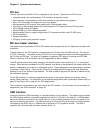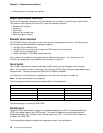
Chapter 2. System board features
Features provided by USB technology include:
Support for hot-pluggable devices
Support for concurrent operation of multiple devices
Suitability for different device bandwidths
Support for up to five meters length from host to hub or from hub to hub
Guaranteed bandwidth and low latencies appropriate for specific devices
Wide range of packet sizes
Limited power to hubs
For information on the connector pin assignments for the USB interface, see “USB port connectors” on
page 33.
Low pin count bus
The low pin count (LPC) bus allows a connection of the ISA and X-Bus devices such as Super I/O. The
PC 300PL Personal Computer uses the National Semiconductor PC87360 Super I/O chip. The PC87360
chip includes the following:
Floppy disk controller
Keyboard and mouse controller
IEEE 1284 parallel port
Two UART serial ports
Wake on LAN support
General purpose input/output (GPIO) ports
PC98 compliance
ACPI compliance
Diskette write protection can be enabled or disabled by a programmable setting in the LPC I/O. This
setting is accessible through the Configuration/Setup Utility program.
Video subsystem
The PC 300PL Personal Computer comes with one of the following graphics solutions:
NumberNine S3 Savage4 Accelerated Graphics Port (AGP) 2X adapter with 8 MB 110 MHz SDRAM
and a 15-pin SVGA connector
NumberNine S3 Savage4 Extreme AGP 4X adapter, with 16 MB 166 MHz SDRAM and a converter for
a 15-pin VGA displays
The Savage4 graphics accelerator supports the following features:
128-bit 2D graphics engine
High-performance 2D/3D video accelerator
3D rendering
Motion video architecture
High-speed memory bus
Flat panel desktop monitor support
Full software support
ACPI and PCI power management
PCI 2.2 bus support, including bus mastering
300 MHz RAMDAC with gamma correction
I2C serial bus and flash ROM support
2.5 V core with 3.3V/5V tolerant I/O
Hardware and BIOS support for VESA timings and DDC monitor communications
Chapter 2. System board features 7


















